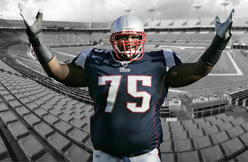This is the halfway point for Vince Wilfork, the New England Patriots and the franchise tag. There has been no movement.
It's been seven days since teams could place the tag on players, and with the Feb. 25 deadline closing in, perhaps a look at Patriots' history with the tag will provide a different lens through which to view the situation.
Adam Vinatieri had mixed results as a franchise player, signing an extension in 2002 and playing on a tender in 2005 before leaving as a free agent.
2002: The Patriots assigned the franchise tag to kicker Adam Vinatieri on the final possible day. The sides had been negotiating an extension, and using the tag gave the sides more time to work out the details. In March, the tag was removed and Vinatieri inked a three-year extension.
2003: Once again waiting until the last possible day, the Patriots assigned the franchise tag to safety Tebucky Jones. Bill Belichick said the team hoped to keep Jones, but the signing of free agent Rodney Harrison helped accelerate trade talks that led to Jones' being shipped to New Orleans for draft picks.
2005: In a replay from 2002, the Patriots waited until the final day before placing the franchise tag on Vinatieri. The sides were reportedly negotiating an extension, but it never came to fruition. Vinatieri played the season on a one-year tender, hit free agency the following offseason and signed with the Indianapolis Colts.
2007: Nowhere close to finding a middle ground, and with talks with cornerback Asante Samuel hitting a stalemate, the Patriots assigned the franchise tag six days before the deadline. At that point, the team obviously felt like there was no reason to wait. Samuels left as a free agent after the season, signing with the Philadelphia Eagles.
2009: On the first possible day, the Patriots assigned the franchise tag to quarterback Matt Cassel. The move was made quickly with the idea that the quicker Cassel signed the tender offer, the quicker a trade could be consummated, since a player without a contract can't be traded. Cassel was dealt to the Kansas City Chiefs.
With those five examples to draw from, it remains unclear which most closely aligns with Wilfork's situation.
In 2007, Asante Samuel had contentious talks in trying to get a long-term deal with New England and bolted as a free agent after one year under the tag.
While the sides are seemingly talking to each other -- which is the only way an extension can be reached -- the view from here is that the odds favor the Patriots' applying the tag by the Feb. 25 deadline, if for nothing else but to buy more time until the financial landscape dramatically changes March 5, when teams will no longer be operating under a salary cap.
So the question is whether it will be a tag-and-extend situation like Vinatieri in 2002, or a contentious tag-and-holdout situation like Samuel in 2007? And how likely is a trade?
It's hard to imagine the Patriots' not making every effort to retain Wilfork. Whether he plays in a 3-4 or 4-3 defensive alignment, Wilfork is an upper-echelon interior lineman in the mold of the Vikings' Pat Williams. When Williams started for the Buffalo Bills (2001-04), he was the nose tackle in the middle of a rock-solid 3-4 run defense; now in Minnesota, he anchors the middle of the 4-3 alignment.
That's one reason why it's a disservice to Wilfork to pigeonhole him as solely a 3-4 nose tackle. Some have suggested the benefits of the Patriots' trading Wilfork and switching to a 4-3 alignment, but regardless of such a switch, the team still would need an athletic run-stuffer in the middle. No one on the present roster is better than Wilfork in that role.
Still, as the Patriots have shown in the past, once they set a value on a player and realize that a middle ground won't be reached, they won't hesitate to move to Plan B.
If they can't lock up Wilfork, would they devote those resources toward making a serious push to sign Julius Peppers? The trickle-down effect of such a move could result in more four-man fronts, with Peppers lining up at end and likely providing a boost in an area the Patriots struggled in 2009 -- the pass rush.
Still, someone will have to fill that big hole in the middle, whether it's the 4-3 or the 3-4.
Could second-year player Ron Brace make a big leap? The returns from his rookie season weren't overly promising.
Or maybe Myron Pryor will continue his ascent; the 2009 sixth-round draft choice was used mostly in sub situations as a rusher. If not one of those two, perhaps a draft pick like Tennessee's Dan Williams, if he's available with the 22nd selection in the first round, could fill that role.
The free-agent market doesn't figure to provide any quick fixes, and filling the spot with a trade, as the Patriots did in 2003 in acquiring Ted Washington, is tougher now because more than one-third of NFL teams are running some version of the 3-4.
That's why, when looking at the Wilfork situation from all angles, it's hard to imagine the Patriots wouldn't want him back. As always, the question will come down to this: at what cost?
The answer to that question, coupled with Wilfork's own financial desires, will ultimately determine where things head.
As 2002 showed with Vinatieri, being assigned the franchise tag can still result in a happy ending between the sides. Then again, as 2007 showed with Samuel, it can also get nasty.
Click here to order Vince Wilfork’s proCane Rookie Card.

(espn.com)



